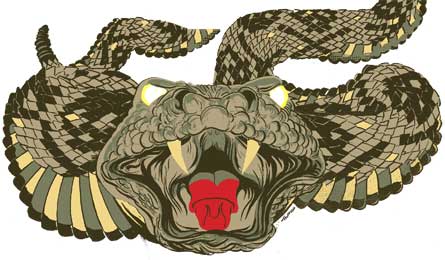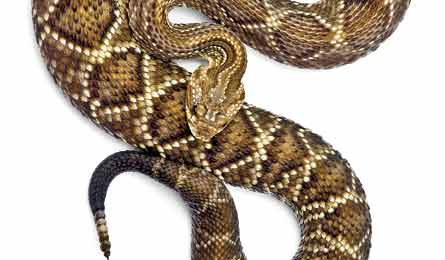Out Alive: Survive a Rattlesnake Bite

'(Illustration by: Jacob Thomas)'

(Illustration by: Jacob Thomas)

(Photo by: Telmo Keim/Age Fotostock)
The Victim: Lorraine Jonsson, 50, of Los Angeles, CA, was bit on April 23, 2010.
Forget a rattler’s early-warning system: By the time I heard the snake shaking its tail, the three-foot serpent had already sunk its fangs into my ankle. Twice. Within seconds, I started feeling the effects: blurred vision, jelly-like legs, and a horrifying sense of panic.
It was four o’clock on a sunny spring Friday in Franklin Canyon Park, a 605-acre greenspace tucked between Los Angeles and the Santa Monica Mountains, and I had just started my favorite post-work hike. I was charging toward the canyon’s ridge when, a hundred feet into the trail, the camouflaged viper struck. I must have stepped right on it. When I saw it coiled under some brush a foot off the path, it was rattling like an out-of-control sprinkler, and only a second had passed since I felt it strike my inner ankle.
I never expected to run into a snake in this urban-boundary park, in terrain I hike several times a week. I wasn’t alert to a possible encounter and I was underdressed for viper-country hiking (not wearing clothing like pants or boots that could have deflected a bite). The 80℉ day presented ideal basking weather and was fading into evening—when snakes and their prey are typically most active. Also, the reptiles’ hunger and mating hormones peak in spring, making them aggressive hunters with hair-trigger defenses.
After the bite, my small (5’4”, 100 pounds) body immediately started reacting to the toxins coursing through it. My system was pumped full of adrenaline, so I wasn’t initially in pain, but I was frantic with fear. The near-lethal doses of venom worked quickly, beginning to incapacitate me within minutes. Like most rattler bites, mine delivered a blood-thinning, tissue-bursting hemotoxin through twin puncture wounds. The vast majority of victims will survive this type of envenomation, albeit uncomfortably. Bruises and blisters start forming around the bite site within a half hour, the venom’s digestive action starts melting tissue near the wound within six hours, and a victim might suffer aches and nausea for days.
My case, though, was more intense. The snake that bit me injected that standard-issue hemotoxin along with a rare and more powerful neurotoxin that quickly interfered with my brain’s signals to my respiratory system. There are only a few North American species that could deliver such a dangerous bite—either a Southern Pacific or a Mojave Green rattlesnake—but I’d stumbled over one of them in my own backyard. I didn’t know it at the time, but I had to get help fast if I was going to survive.
I hadn’t told anyone where I’d be hiking, and even though I was on the border of a major city, the canyon’s 200-foot hills block most cell signals. I stumbled the short distance to the pavement and fell to the ground, yelling for help and fighting to stay conscious as my muscles trembled with spasms. Luckily, a car appeared within a few minutes. The passing couple pulled me into their backseat and drove through the park until we found a ranger who called an ambulance.
Meanwhile, my entire body continued shutting down; the paramedics didn’t even realize what a severe bite I’d received until they had to resuscitate me en route to the emergency room. I’d stopped breathing as my lungs succumbed to the toxins attacking them. Thankfully, the hospital was only six miles away. Within an hour of my bite, doctors administered the first of 116 vials of antivenin that would ultimately save my life.
Over the next three weeks, I stayed in the ICU, tortured by the snake-like hissing sound of the respirator and recovering from massive swelling and organ failure caused by the venom double-whammy. If it hadn’t been for my proximity to the hospital and my healthy heart—thanks in part to those regular canyon hikes—I wouldn’t have made it.
Key Skill: Don’t surprise a snake.
Stay alert, especially on overgrown trails where vipers may wait for passing prey, and when cool temps lure snakes into open areas to bask. Step on top of logs and rocks instead of over; a rattler might strike defensively if it’s hiding underneath and you surprise it.
Never Forget: It’s not out to get you.
If a snake is in motion, get out of its way. If it’s coiled, give it a wide berth (at least 10 feet) and go around it. Snakes can only extend up to 40 percent of their body length during a strike, but you can’t jump out of the way; from start to finish, the motion takes less than half a second.
Snakebite First Aid
1. Remove jewelry or clothing that may restrict circulation near the bite because of swelling. Struck in the foot or leg? Don’t remove your shoe. You may not be able to put it back on to hike out.
2. Wash the wound. That’s all. Don’t do anything else to the bite site.
3. Keep the wound at heart level. (For lower limbs, it’s OK to walk.)
4. Evacuate. Get to a hospital ASAP. Pain and swelling may be severe, and within six hours the flesh around the wound may start to die.